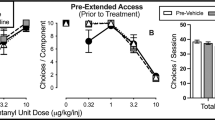Abstract
The purpose of the present study was to determine the relative intrinsic efficacy of various opioids using the irreversible μ opioid antagonist beta-funaltrexamine (βFNA). To this end, pigeons were trained to discriminate 3.0 (n=6) or 1.8 (n=1) mg/kg morphine from distilled water in a two-key, food-reinforced, drug discrimination procedure. The µ opioids fentanyl, l-methadone, buprenorphine, butorphanol, nalorphine, nalbuphine and levallorphan, as well as the δ opioid BW373U86, substituted completely for the morphine stimulus. The stimulus effects of morphine were antagonized (i.e., produced a significant increase in the ED50 value) by a 10 mg/kg but not a 5 mg/kg dose of βFNA. Antagonist effects of βFNA were observed following a 2-h pretreatment, but not following 26-, 50-, 74-, 98- or 146-h pretreatments. The stimulus effects produced by fentanyl, l-methadone and buprenorphine were not antagonized by doses of βFNA as high as 20, 10 and 10 mg/kg, respectively. The lowest dose of βFNA required to antagonize the stimulus effects of butorphanol was 10 mg/kg, whereas the effects of nalorphine, nalbuphine and levallorphan were antagonized by a dose of βFNA as low as 5 mg/kg. The δ opioid BW373U86 substituted for the morphine stimulus, and this effect was not antagonized by 10 mg/kg βFNA. The pkB values for naloxone (1.0 mg/kg) against the stimulus effects of fentanyl (6.70) and morphine (6.52) were considerably higher than that for BW373U86 (4.60), indicating further that the morphine-like stimulus effects produced by BW373U86 were not mediated by activity at the µ opioid receptor. These findings indicate that the strategy of irreversible antagonism can be used effectively to differentiate opioids with varying degrees of intrinsic efficacy at the µ opioid receptor in a pigeon drug discrimination procedure. In particular, the ranking of these drugs by relative intrinsic efficacy at the µ opioid receptor is: l-methadone=fentanyl≥buprenorphine≥morphine≥ butorphanol>nalorphine=nalbuphine=levallorphan. Additionally, the short-acting effect of βFNA in the pigeon suggests that the recovery of µ opioid receptor function varies across species.
Similar content being viewed by others
Author information
Authors and Affiliations
Additional information
Received: 19 August 1997 / Final version: 28 March 1998
Rights and permissions
About this article
Cite this article
Morgan, D., Picker, M. The µ opioid irreversible antagonist beta-funaltrexamine differentiates the discriminative stimulus effects of opioids with high and low efficacy at the μ opioid receptor. Psychopharmacology 140, 20–28 (1998). https://doi.org/10.1007/s002130050734
Issue Date:
DOI: https://doi.org/10.1007/s002130050734




